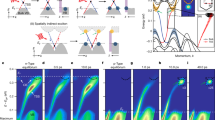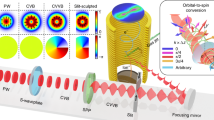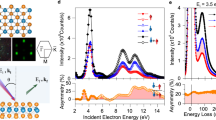Abstract
Recently discovered materials called three-dimensional topological insulators1,2,3,4,5 constitute examples of symmetry-protected topological states in the absence of applied magnetic fields and cryogenic temperatures. A hallmark characteristic of these non-magnetic bulk insulators is their protected metallic Dirac fermion-like surface states. Electrons in these surface states are spin polarized with their spins governed by their momentum, resulting in a helical spin texture in momentum space6. Spin- and angle-resolved photoemission spectroscopy has been the only tool capable of directly observing this central feature with simultaneous energy, momentum and spin sensitivity6,7,8,9,10,11,12. By using an innovative photoelectron spectrometer13 with a high-flux laser-based light source, we discovered a surprising property of these surface electrons. We found that the spin polarization of the resulting photoelectrons can be manipulated in three dimensions through selection of the light polarization. These effects are due to the spin-dependent interaction of the helical surface electrons with light, which originates from strong spin–orbit coupling. Our results illustrate unusual scenarios in which the spin polarization of photoelectrons is completely different from that of the originating initial states. The results also provide the basis for a source of highly spin-polarized electrons with tunable polarization direction.
This is a preview of subscription content, access via your institution
Access options
Subscribe to this journal
Receive 12 print issues and online access
$259.00 per year
only $21.58 per issue
Buy this article
- Purchase on SpringerLink
- Instant access to full article PDF
Prices may be subject to local taxes which are calculated during checkout




Similar content being viewed by others
Change history
13 March 2013
In the version of this Letter originally published online, in Figure 4a, the angle between the +x direction and the spin direction at momentum k should have been labelled θs, and the angle between the +x direction and k should have been labelled θk. This error has now been corrected in all versions of the Letter.
References
Fu, L., Kane, C. L. & Mele, E. J. Topological insulators in three dimensions. Phys. Rev. Lett. 98, 106803 (2007).
Moore, J. E. & Balents, L. Topological invariants of time-reversal-invariant band structures. Phys. Rev. B 75, 121306 (2007).
Roy, R. Topological phases and the quantum spin Hall effect in three dimensions. Phys. Rev. B 79, 195322 (2009).
Qi, X-L. & Zhang, S-C. The quantum spin Hall effect and topological insulators. Phys. Today 63, 33–38 (2010).
Moore, J. E. The birth of topological insulators. Nature 464, 194–198 (2010).
Hsieh, D. et al. A tunable topological insulator in the spin helical Dirac transport regime. Nature 460, 1101–1105 (2009).
Hsieh, D. et al. Observation of unconventional quantum spin textures in topological insulators. Science 323, 919–922 (2009).
Nishide, A. et al. Direct mapping of the spin-filtered surface bands of a three-dimensional quantum spin Hall insulator. Phys. Rev. B 81, 041309 (2010).
Pan, Z-H. et al. Electronic structure of the topological insulator Bi2Se3 using angle-resolved photoemission spectroscopy: Evidence for a nearly full surface spin polarization. Phys. Rev. Lett. 106, 257004 (2011).
Souma, S. et al. Direct measurement of the out-of-plane spin texture in the Dirac-cone surface state of a topological insulator. Phys. Rev. Lett. 106, 216803 (2011).
Xu, S-Y. et al. Topological phase transition and texture inversion in a tunable topological insulator. Science 332, 560–564 (2011).
Jozwiak, C. et al. Widespread spin polarization effects in photoemission from topological insulators. Phys. Rev. B 84, 165113 (2011).
Jozwiak, C. et al. A high-efficiency spin-resolved photoemission spectrometer combining time-of-flight spectroscopy with exchange-scattering polarimetry. Rev. Sci. Instrum. 81, 053904 (2010).
Qi, X-L., Hughes, T. L. & Zhang, S-C. Topological field theory of time-reversal invariant insulators. Phys. Rev. B 78, 195424 (2008).
Fu, L. & Kane, C. L. Superconducting proximity effect and Majorana fermions at the surface of a topological insulator. Phys. Rev. Lett. 100, 096407 (2008).
Nayak, C., Simon, S. H., Stern, A., Freedman, M. & Das Sarma, S. Non-Abelian anyons and topological quantum computation. Rev. Mod. Phys. 80, 1083–1159 (2008).
Roushan, P. et al. Topological surface states protected from backscattering by chiral spin texture. Nature 460, 1106–1109 (2009).
Peng, H. et al. Aharonov–Bohm interference in topological insulator nanoribbons. Nature Mater. 9, 225–229 (2010).
Hsieh, D. et al. Nonlinear optical probe of tunable surface electrons on a topological insulator. Phys. Rev. Lett. 106, 057401 (2011).
McIver, J. W., Hsieh, D., Steinberg, H., Jarillo-Herrero, P. & Gedik, N. Control over topological insulator photocurrents with light polarization. Nature 7, 96–100 (2012).
Zhang, H. et al. Topological insulators in Bi2Se3, Bi2Te3 and Sb2Te3 with a single Dirac cone on the surface. Nature Phys. 5, 438–442 (2009).
Park, C-H. & Louie, S. G. Spin polarization of photoelectrons from topological insulators. Phys. Rev. Lett. 109, 097601 (2012).
Xia, Y. et al. Observation of a large-gap topological-insulator class with a single Dirac cone on the surface. Nature Phys. 5, 398–402 (2009).
Hoesch, M. et al. Spin structure of the Shockley surface state on Au(111). Phys. Rev. B 69, 241401 (2004).
Mirhosseini, H. & Henk, J. Spin texture and circular dichroism in photoelectron spectroscopy from the topological insulator Bi2Te3: First-principles photoemission calculations. Phys. Rev. Lett. 109, 036803 (2012).
Henk, J., Ernst, A. & Bruno, P. Spin polarization of the L-gap surface states on Au(111). Phys. Rev. B 68, 165416 (2003).
Kim, B. et al. Spin and orbital angular momentum structure of Cu(111) and Au(111) surface states. Phys. Rev. B 85, 195402 (2012).
King, P. D. C. et al. Large tunable Rashba spin splitting of a two-dimensional electron gas in Bi2Se3 . Phys. Rev. Lett. 107, 096802 (2011).
Ishizaka, K. et al. Giant Rashba-type spin splitting in bulk BiTeI. Nature Mater. 10, 521–526 (2011).
Pierce, D. T. et al. The GaAs spin polarized electron source. Rev. Sci. Instrum. 51, 478–499 (1980).
Acknowledgements
We thank G. Lebedev and W. Wan for work with the electron optics, W. Zhang, D. A. Siegel, C. L. Smallwood and T. Miller for useful discussions, H. Wang and R. A. Kaindl for advice with optics, and A. Bostwick for help with software development. This work was supported by the Director, Office of Science, Office of Basic Energy Sciences, Division of Materials Sciences and Engineering, of the US Department of Energy under Contract No. DE-AC02-05CH11231 (Lawrence Berkeley National Laboratory). Higher-photon-energy photoemission work was performed at the Advanced Light Source, Lawrence Berkeley National Laboratory, which is supported by the Director, Office of Science, Office of Basic Energy Sciences, of the US Department of Energy under Contract No. DE-AC02-05CH11231.
Author information
Authors and Affiliations
Contributions
C.J. developed the experimental system. C.J., C-H.P. and C.H. devised the experiment. C.J. and K.G. carried out the experiment. C.J. analysed the experimental data. Calculations were performed by C-H.P., S.G.L. and D-H. L. Samples were prepared by C.R.R. and R.J.B. Synchrotron data were acquired by J.D.D., C.J. and K.G. Z.H. and A.L. were responsible for experiment planning and infrastructure. All authors contributed to the interpretation and writing of the manuscript.
Corresponding author
Ethics declarations
Competing interests
The authors declare no competing financial interests.
Supplementary information
Supplementary Information
Supplementary Information (PDF 1058 kb)
Rights and permissions
About this article
Cite this article
Jozwiak, C., Park, CH., Gotlieb, K. et al. Photoelectron spin-flipping and texture manipulation in a topological insulator. Nature Phys 9, 293–298 (2013). https://doi.org/10.1038/nphys2572
Received:
Accepted:
Published:
Issue date:
DOI: https://doi.org/10.1038/nphys2572
This article is cited by
-
Observation of spin-momentum locked surface states in amorphous Bi2Se3
Nature Materials (2023)
-
Reversal of spin-polarization near the Fermi level of the Rashba semiconductor BiTeCl
npj Quantum Materials (2023)
-
Rashba-like physics in condensed matter
Nature Reviews Physics (2022)
-
Studying local Berry curvature in 2H-WSe2 by circular dichroism photoemission utilizing crystal mirror plane
Scientific Reports (2021)
-
A case study for the formation of stanene on a metal surface
Communications Physics (2019)



